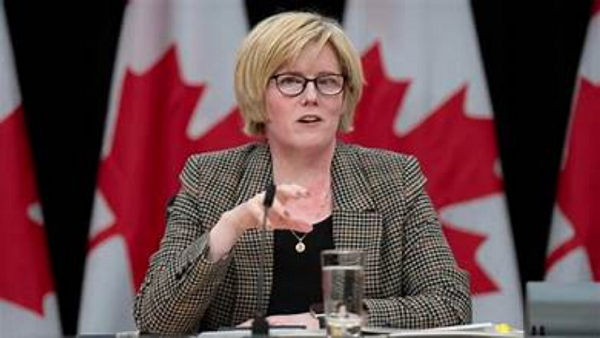Economists’ predictions on interest rate cuts this year are too optimistic, National Bank CEO warns
Economic forecasts predicting interest rate cuts in 2024 are too optimistic, according to National Bank of Canada NA-T chief executive officer Laurent Ferreira, as concerns mount that persistently high rates will weigh even more on homeowners this year when swaths of mortgages come due for renewal.
Mortgage renewals this year will force homeowners who locked in loans when interest rates were low in 2019 to adjust to the financial shock of the Bank of Canada’s aggressive hike campaign over the past few years.
While economists and analysts expect central banks to start lowering rates this year, Mr. Ferreira said during a Tuesday conference hosted by Royal Bank of Canada that continuing geopolitical risks and the increasing costs of the energy transition could affect food prices and cause trade disruptions – factors that would prop up inflation.
“We are expecting some rate cuts in Canada in 2024, but I do believe that a no-growth, persistent inflation scenario for the next few quarters is possible,” Mr. Ferreira said. “That would prevent more aggressive cuts and earlier cuts as well from the central bank.”
A summary of the Bank of Canada’s governing council meeting released in December indicated that the central bank has not yet ruled out further hikes, but that interest rates are “sufficiently restrictive” to control inflation – suggesting that the next discussion will look at beginning to ease monetary policy. Meanwhile, minutes released last week from the U.S. Federal Reserve showed policy makers maintaining current rates for some time, while acknowledging that the Fed could start cutting in 2024.
While most mortgage renewals will come up in 2025 and 2026 when rates are expected to have fallen, a batch is set for this year.
At RBC, 14 per cent of the bank’s $300-billion mortgage portfolio will renew in 2024, compared with 25 per cent to 30 per cent in coming years. The bank anticipates an average payment jump of $400 a month or an increase of about 25 per cent, RBC chief executive Dave McKay said during the conference. However, consumers are capable of managing those shocks, he added.
Homeowners have changed their spending habits and used their savings – which were built up during the pandemic – to absorb the mortgage cost increases, Mr. McKay said. Wages have grown since 2019, and employment levels are expected to remain stable this year.
The looming pressure from potentially fraught mortgage renewals is hitting the banks as they contend with rising regulatory capital requirements, higher expenses and climbing loan loss concerns.
The greatest risk in the banks’ real estate books lies in commercial properties, which have seen valuations slump, particularly in offices spaces as many employees continue to work in hybrid settings.
“We expect 2024 to be worse than 2023 on a number of fronts. Commercial real estate will continue in the United States to see some pain,” Mr. McKay said. “And while we’ve seen, you know, no losses to date in our Canadian commercial real estate book, you might see the odd loss.”
Delinquency rates in credit cards are also climbing as losses increase from their low levels during the COVID-19 pandemic when government stimulus injected excess cash into consumers’ wallets.
If rates remain higher for longer, elevated borrowing costs could continue to dampen demand for loans, especially among individuals and businesses that could opt to delay investing in new purchases or projects until costs ease.
“If I told you that in a transaction that you were considering undertaking – whether it was to upgrade your home or do a renovation or to buy a company – if you’re a commercial or a corporate client and you don’t need to do it today, and the high likelihood is that if you do it in six or nine months from now, it’s going to be 100 basis points cheaper, what are you going to do? You’re going to wait,” Bank of Montreal CEO Darryl White said.
BMO integrated its takeover of California-based Bank of the West in September. Mr. White said that recent market volatility and continuing economic turmoil has had little impact on the lender’s revenue and cost targets over the next five years.
Rare opportunities to scoop up rivals have popped up in Canada over the past year. RBC’s RY-T +0.02% increase proposed acquisition of the Canadian subsidiary of Britain-based HSBC Holding PLC received approval from the federal government in December – the last green light required to close the deal.
Laurentian Bank of Canada LB-T -0.40%decrease
also put itself on the auction block over the summer, but the lender failed to attract a buyer. In late September, a multiday system outage prompted the board to oust CEO Rania Llewellyn when the bank was halfway through a three-year turnaround strategy.
New CEO Éric Provost, formerly the head of personal and commercial banking, said Tuesday that the bank plans to launch a revised turnaround strategy this year to bolster its beleaguered share price. Laurentian’s stock was the worst performer among the major banks last year.
“Customer centricity, efficiency and simplification, and making sure that we make the right fundamental technology investment in the future will allow us to revisit some of the structures we have in place,” Mr. Provost said.
This article was reported by The Globe and Mail
















